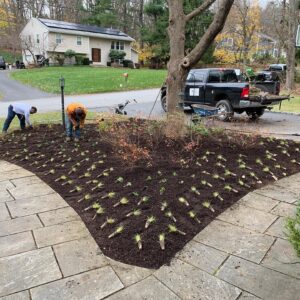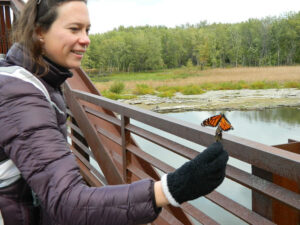
Rewilding is a term distinct to our modern age, where so much nature has been lost to development and human growth.
Rewilding describes what we are doing when we plant native, remove invasives, or plant for pollinators.
To rewild is simply to plant native plants; to put back the plants that were once here. Plants native to the Northeast provide habitat and multiple ecosystem services. Consider a white oak tree, for example. It has leaves that function as food for a caterpillar, a canopy that shades and cools, a woody biomass that sequesters carbon dioxide, and roots that absorb water and prevent flooding.
The area we inhabit is Ecoregion 59C, the Southern New England Coastal Plains and Hills, as determined by the Environmental Protection Agency (EPA). This ecoregion covers most of Westchester and was formed by a rise in temperature about 20,000 years ago, which led to the retreat of the Wisconsin Glacier.
After the glacier, Westchester’s hilly landscape became reforested with oaks, maples, white pines, elms, chestnuts, and hemlocks. Half a millennium ago, Westchester’s wild landscape had more biodiversity per acre than Yellowstone Park. Bears, wolves, mountain lions, and beavers roamed throughout, and the sound of songbirds was “deafening,” according to an early Colonial naturalist.
Over time, our landscape became carved up with roads, towns, houses, buildings, and much of the wild was paved over. Invasive plant species came with colonists and merchants, and began to re-shape and diminish our native biodiversity.
We can’t return Westchester’s landscape to the way it was pre-development, but we can rewild and plant native throughout the pockets and patchwork of our yards. At Plan it Wild, we plant species that are best adapted to this 59C ecoregion, along with “friendlies” –– plants originating from outside the ecoregion that provide habitat function.
Our goal is to transform backyards and commercial spaces into habitat attractive to pollinators, insects, birds, and small mammals, and to bring back Westchester’s wild legacy and its beauty.
![]()
Get Ready to Go Rewild!
Rewilding can be done by anyone, on any land type. You can do it yourself or use a landscaping company. Here are three strategies to get you started:
- Enlarge planting beds and plant native – in the fall, see where the leaves drop on the lawn under a tree; that’s a good indication of where to enlarge your planting beds and replace the lawn with native groundcovers.
- Remove invasive shrubs and overseed the area with low–mow grass and clover. Then string trim anything that gets above six inches. While you’re deciding where to plant a native shrub or a tree to support bird habitat, the low–mow grass will hold the ground and prevent new weeds, while the clover will feed the bees.
- Plant a native tree. See if you can source a black cherry. Otherwise, plant a white oak or a red maple; both are easy to grow and are very adaptable species.
 Amanda Bayley is the CEO & Co-Founder of Plan it Wild, a sustainable land management company that is bringing back native habitats to Westchester yards and commercial spaces. More Nature. Now. PLANitWILD.com
Amanda Bayley is the CEO & Co-Founder of Plan it Wild, a sustainable land management company that is bringing back native habitats to Westchester yards and commercial spaces. More Nature. Now. PLANitWILD.com






